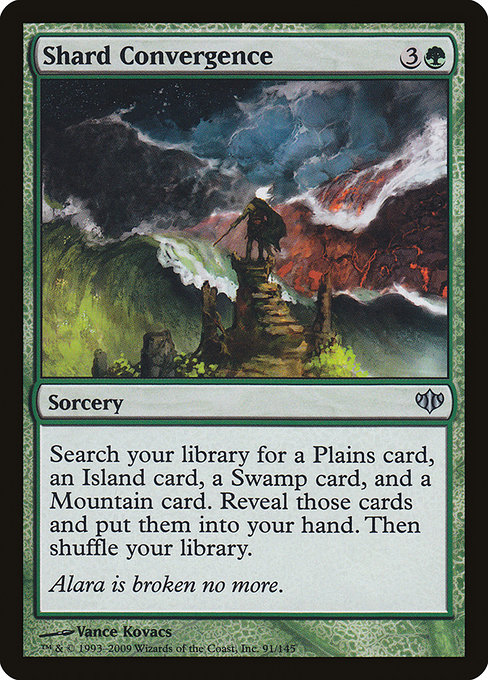
Image courtesy of Scryfall.com
Predictive analytics and set design: Shard Convergence as a lens
In the world of Magic, set design is a grand experiment of constraints and possibilities. When designers chart out a new block, they aren't just drawing pretty creatures; they're forecasting how new cards will play in real games, how mana will flow, and how collectors will respond to ramps, fetches, and finishers. Predictive analytics has become a quiet partner in that process, offering a data-driven way to test hypotheses about rarity distribution, color balance, and the health of the mana base. 🧙♂️🔥💎
The card in focus: Shard Convergence
- Mana cost: 3G — a cost that lands in a midgame play window and rewards green's natural mana ramp. ⚔️
- Type and rarity: Sorcery, uncommon, from the Conflux set. Its uncommon status reflects a design space where a single spell can enable a multi-face strategy without overpowering the limited environment. 🧙♂️
- Effect: Search your library for a Plains card, an Island card, a Swamp card, and a Mountain card. Reveal those cards, put them into your hand, then shuffle. This is a precise toolkit for mana-fix: you can assemble a four-color mana base for a multi-color deck with four shards represented. 🎨
From a gameplay perspective, this is green-led color fixing wrapped in a strategic fetch. It doesn't fetch dual lands or non-basic utility lands; instead, it ensures players can access the four basic lands that map to white, blue, black, and red in a single, targeted spell. That design choice is both elegant and practical, especially in a time when tri-color and four-color decks were exploring new space on the competitive scene. The flavor text—“Alara is broken no more”—speaks to a world where the balance among shards is constantly tested, and the land itself becomes the currency of that balance. 🧙♂️
How data informs such a choice
In modern design pipelines, analysts might run simulations that forecast the mana-smoothness of a set under different launch drafts and constructed formats. They measure metrics like average mana curve stability, the frequency of games where a green fetch spell enables a reliable turn-4 or turn-5 play, and how often environments require color-fixing in the opening turns. Shard Convergence is a case study in targeted fixing: you don’t want to over-fixate on too many non-basics or risk bottlenecks later in the game. A well-timed fixation spell can empower a spectrum of strategies, from mono-green ramp to four-color midrange and even hybrid splashes for control or combo builds. The analytics team would track how often players use the fetch to assemble a mana base that supports their plan—whether they’re deploying a big dragon, a planeswalker, or a handful of early removal. 🧠📈
From collector to commander: broadened reach
Shard Convergence sits in the Conflux set, a nexus where three-aligned shards collide, and the five-identity color wheel flexes its muscles. The decision to print an uncommon sorcery with a powerful, fetch-all-four-lands effect corresponds with a design philosophy that respects both casual and competitive players. For Commander players, the card reads as a robust mana-enabler for four-color decks, while for Modern players, the card’s legal status adds a splash of quirky practicality to modern green shells. The card’s color identity remains green, but its practical effect touches white, blue, black, and red in a way that invites creative deckbuilding—without stepping on the toes of dedicated mana-fixers like Farseek or Chromatic Lantern. 🔥🧭
“Predictive analytics turns ‘what if’ into a map,” one designer might say. “If we know players crave consistent mana in multi-color games, a well-timed fetch spell becomes a compass.”
Design takeaways for future sets
- Mana-fixing density: Balance is key. Too many fixing spells can dilute the sense of progression; too few can strangle multi-color ambitions. Shard Convergence shows how one well-timed card can unlock a family of strategies. ⚡
- Rarity alignment: An uncommon slot allows ambitious effects without undermining draft balance or coveted rare slots. The Conflux era leaned into this approach to preserve variety and surprise. 💎
- Flavor ties to mechanics: The water-tight hook between the card’s text and Alara’s fractured world makes the land search feel thematically earned. It’s a reminder that good design blends playability with story. 🎨
- Cross-format relevance: Designing for both Commander and Modern means thinking about long-tail value and practical mana needs across playstyles — a core idea behind set design analytics. 🧭
Why this matters to fans and players
For collectors, the card’s uncommon rarity in Conflux and its art by Vance Kovacs carry a particular charm. The piece sits on shelves where nostalgia meets utility: a reminder of a time when Gateways and fetchers started to redefine the mana economy in color-m heavy formats. The market data—while not the only driver—helps explain why designers introduced cross-color pickups: to keep games engaging and to reward thoughtful sequencing rather than brute force draws. The two-minute thrill of finding the exact combination of plains, island, swamp, and mountain mirrors the thrill of a well-executed bluff in a draft. 🎲⚔️
In the end, predictive analytics isn't about turning MTG into spreadsheet soup; it's about building worlds that feel fair, dynamic, and inviting. It’s about ensuring that a green spell with a big fetch pays off not just in game terms, but in storytelling terms—especially when the shard-torn world of Alara finally stitches itself back together, at least for a moment, in your opening hand. 🧙♂️💚